Characteristics of Marine Heatwaves in the Japan/East Sea
Abstract
:1. Introduction
2. Data and Methods
2.1. Data Description
2.2. Detection of Marine Heatwaves
2.3. Marine Heatwave Indices
2.4. Ekman Pumping
2.5. Net Surface Heat and Freshwater Flux
2.6. Empirical Orthogonal Function Analysis
3. Results
3.1. Statistical Characteristics
3.2. Seasonal Variability
3.3. Interannual Variability and Long-Term Trends
3.4. Factors Associated with Long-Term Trends in Marine Heatwaves
4. Discussion and Conclusions
5. Summary
- (1)
- JES MHWs occurred about twice per year, with a mean MHWD and a mean Imean of 12.6 days and 2.4 °C, respectively. MHWs with a short duration and weak intensity dominated in this region. A duration of 5 days and a mean intensity of 2.1 °C were particularly common. High MHWTy and high SST anomalies were both observed in the western JES at approximately 40° N.
- (2)
- Both the spatial and temporal distributions of MHW indices were subject to strong seasonal variability. The maximum values of the regional averaged MHWTm, MHWIm, and MHWIMm (4.6 days, 12.6 °C days, and 2.8 °C, respectively) all occurred in August. However, a high MHWIm and MHWIMm in the western corner of the JES also appeared in winter (from December to February) and spring (from May to March). The MHWs in the eastern JES were also active in September.
- (3)
- The MHWTy and MHWIy have increased significantly in recent years over the entire JES, except for the Russian coastal regions and the Tsushima Strait. Significantly positive trends were observed in the MHWTy (12.01 ± 3.48 days/decade) and the MHWIy (29.62 ± 9.00 °C days/decade), which are still significant when the global averaged SST trend is removed. A prolonged MHW event in the western JES lasting more than 200 days (from August 2019 to spring of 2020) is an example of this increasing trend. The increasing trend in the MHWIMy (0.07 ± 0.07 °C/decade) is rather trivial. The EOF1 of the MHWIy accounts for 44.89% of the total variance. The corresponding time coefficient shows a significantly increasing trend.
- (4)
- The average JES MHWN was 1.97 occurrences, which is slightly higher than the global average level of 1.82 occurrences. However, regional comparison results indicate that the increasing trend of the MHWIy in the JES is twice that of the global averaged MHWI trend of 12.37 °C days/decade.
Author Contributions
Funding
Data Availability Statement
Acknowledgments
Conflicts of Interest
References
- Hobday, A.J.; Alexander, L.V.; Perkins, S.E.; Smale, D.A.; Straub, S.C.; Oliver, E.; Benthuysen, J.A.; Burrows, M.T.; Donat, M.G.; Peng, M.; et al. A hierarchical approach to defining marine heatwaves. Prog. Oceanogr. 2016, 141, 227–238. [Google Scholar] [CrossRef] [Green Version]
- Sparnocchia, S.; Schiano, M.E.; Picco, P.; Cappellrtti, A. The anomalous warming of summer 2003 in the surface layer of the Central Ligurian Sea (Western Mediterranean). Ann. Geophys. 2006, 24, 443–452. [Google Scholar] [CrossRef]
- Garrabou, J.; Coma, R.; Bensoussan, N.; Bally, M.; Chevaldonné, P.; Cigliano, M.; Diaz, D.; Harmelin, J.G.; Gambi, M.C.; Kersting, D.K.; et al. Mass mortality in northwestern mediterranean rocky benthic communities: Effects of the 2003 heat wave. Glob. Chang. Biol. 2009, 15, 1090–1103. [Google Scholar] [CrossRef]
- Frölicher, T.L.; Laufkötter, C. Emerging risks from marine heat waves. Nat. Commun. 2018, 9, 650. [Google Scholar] [CrossRef] [PubMed]
- Scannell, H.A.; Pershing, A.J.; Alexander, M.A.; Thomas, A.C.; Mills, K.E. Frequency of marine heatwaves in the North Atlantic and North Pacific since 1950. Geophys. Res. Lett. 2016, 43, 2069–2076. [Google Scholar] [CrossRef] [Green Version]
- FröLicher, T.L.; Fischer, E.M.; Gruber, N. Marine heatwaves under global warming. Nature 2018, 560, 360–364. [Google Scholar] [CrossRef]
- Bond, N.A.; Cronin, M.F.; Freeland, H.; Mantua, N. Causes and impacts of the 2014 warm anomaly in the NE Pacific. Geophys. Res. Lett. 2015, 42, 3414–3420. [Google Scholar] [CrossRef]
- Di Lorenzo, E.; Mantua, N. Multi-year persistence of the 2014/15 North Pacific marine heatwave. Nat. Clim. Chang. 2016, 6, 1042–1048. [Google Scholar] [CrossRef]
- Chen, W.; Lu, R.; Dong, B. Intensified anticyclonic anomaly over the western North Pacific during El Niño decaying summer under a weakened Atlantic thermohaline circulation. J. Geophys. Res. Atmos. 2014, 119, 13637–13650. [Google Scholar] [CrossRef] [Green Version]
- Rodrigues, R.R.; Taschetto, A.S.; Gupta, A.S.; Foltz, G.R. Common cause for severe droughts in South America and marine heatwaves in the South Atlantic. Nat. Geosci. 2019, 12, 620–626. [Google Scholar] [CrossRef]
- Pearce, A.; Lenanton, R.; Jackson, G.; Moore, J.; Feng, M.; Gaughan, D. The “Marine Heat Wave” Off Western Australia during the Summer of 2010/11; Fisheries Research Report No. 222; Department of Fisheries: Perth, Australia, 2011; 40p.
- Benthuysen, J.A.; Oliver, E.C.; Feng, M.; Marshall, A.G. Extreme marine warming across tropical Australia during austral summer 2015–2016. J. Geophys. Res. Ocean. 2018, 123, 1301–1326. [Google Scholar] [CrossRef]
- Darmaraki, S.; Somot, S.; Sevault, F.; Nabat, P. Past variability of Mediterranean Sea marine heatwaves. Geophys. Res. Lett. 2019, 46, 9813–9823. [Google Scholar] [CrossRef] [Green Version]
- Carvalho, K.S.; Smith, T.E.; Wang, S. Bering Sea marine heatwaves: Patterns, trends and connections with the Arctic. J. Hydrol. 2021, 600, 126462. [Google Scholar] [CrossRef]
- Li, Y.; Ren, G.; Wang, Q.; You, Q. More extreme marine heatwaves in the China Seas during the global warming hiatus. Environ. Res. Lett. 2019, 14, 104010. [Google Scholar] [CrossRef]
- Gao, G.; Marin, M.; Feng, M.; Yin, B.; Yang, D.; Feng, X.; Ding, Y.; Song, D. Drivers of marine heatwaves in the East China Sea and the South Yellow Sea in three consecutive summers during 2016–2018. J. Geophys. Res. Ocean. 2020, 125, e2020JC016518. [Google Scholar] [CrossRef]
- Yao, Y.; Wang, J.; Yin, J.; Zou, X. Marine heatwaves in China’s marginal seas and adjacent offshore waters: Past, Present, and Future. J. Geophys. Res. Ocean. 2020, 125, e2019JC015801. [Google Scholar] [CrossRef]
- Yao, Y.; Wang, C. Variations in summer marine heatwaves in the South China Sea. J. Geophys. Res. Ocean. 2021, 126, e2021JC017792. [Google Scholar] [CrossRef]
- Oliver, E.C.; Benthuysen, J.C.; Bindoff, N.L.; Hobday, A.J.; Holbrook, N.J.; Mundy, C.N.; Perkins-Kirkpatrick, S.E. The unprecedented 2015/16 Tasman Sea marine heatwave. Nat. Commun. 2017, 8, 16101. [Google Scholar] [CrossRef] [Green Version]
- Oliver, E.; Lago, V.; Hobday, A.J.; Holbrook, N.J.; Ling, S.D.; Mundy, C.N. Marine heatwaves off eastern Tasmania: Trends, interannual variability, and predictability. Prog. Oceanogr. 2018, 161, 116–130. [Google Scholar] [CrossRef]
- Salinger, M.J.; Renwick, J.; Behrens, E.; Mullan, A.B.; Diamond, H.J.; Sirguey, P.; Smith, R.O.; Trought, M.C.T.; Alexander, V.L.; Cullen, N.J.; et al. The unprecedented coupled ocean-atmosphere summer heatwave in the New Zealand region 2017/18: Drivers, mechanisms and impacts. Environ. Res. Lett. 2019, 14, 044023. [Google Scholar] [CrossRef]
- Gentemann, C.L.; Fewings, M.R.; García-Reyes, M. Satellite sea surface temperatures along the West Coast of the United States during the 2014–2016 northeast Pacific marine heat wave. Geophys. Res. Lett. 2017, 44, 312–319. [Google Scholar] [CrossRef]
- Manta, G.; de Mello, S.; Trinchin, R.; Badagian, J.; Barreiro, M. The 2017 Record Marine Heatwave in the Southwestern Atlantic Shelf. Geophys. Res. Lett. 2018, 45, 12449–12456. [Google Scholar] [CrossRef]
- Hughes, T.P.; Kerry, J.T.; Álvarez-Noriega, M.; Álvarez-Romero, J.G.; Anderson, K.D.; Baird, A.H.; Babcock, R.C.; Beger, M.; Bellwood, D.R.; Berkelmans, R.; et al. Global warming and recurrent mass bleaching of corals. Nature 2017, 543, 373–377. [Google Scholar] [CrossRef] [PubMed]
- Smale, D.A.; Wernberg, T.; Oliver, E.C.; Thomsen, M.; Harvey, B.P.; Straub, S.C.; Burrows, M.T.; Alexander, L.V.; Benthuysen, J.A.; Donat, M.G.; et al. Marine heatwaves threaten global biodiversity and the provision of ecosystem services. Nat. Clim. Chang. 2019, 9, 306–312. [Google Scholar] [CrossRef] [Green Version]
- Benthuysen, J.A.; Oliver, E.C.; Chen, K.; Wernberg, T. Advances in understanding marine heatwaves and their impacts. Front. Mar. Sci. 2020, 7, 147. [Google Scholar] [CrossRef] [Green Version]
- Hu, S. Observed strong subsurface marine heatwaves in the tropical western Pacific Ocean. Environ. Res. Lett. 2021, 16, 104024. [Google Scholar] [CrossRef]
- Caputi, N.; Kangas, M.; Denham, A.; Feng, M.; Pearce, A.; Hetzel, Y.; Chandrapavan, A. Management adaptation of invertebrate fisheries to an extreme marine heat wave event at a global warming hot spot. Ecol. Evol. 2016, 6, 3583–3593. [Google Scholar] [CrossRef]
- Mills, K.E.; Pershing, A.J.; Brown, C.J.; Chen, Y.; Chiang, F.-S.; Holland, D.S.; Lehuta, S.; Nye, J.A.; Sun, J.C.; Thomas, A.C.; et al. Fisheries management in a changing climate: Lessons from the 2012 ocean heat wave in the Northwest Atlantic. Oceanography 2013, 26, 191–195. [Google Scholar] [CrossRef] [Green Version]
- Seager, R.; Hoerling, M.; Schubert, S.; Wang, H.; Lyon, B.; Kumar, A.; Nakamura, J.; Henderson, N. Causes of the 2011–2014 California drought. J. Clim. 2015, 28, 6997–7024. [Google Scholar] [CrossRef]
- Cheng, L.; Abraham, J.; Hausfather, Z.; Trenberth, K.E. How fast are the oceans warming? Science 2019, 363, 128–129. [Google Scholar] [CrossRef]
- Plecha, S.M.; Soares, P.M.M. Global marine heatwave events using the new CMIP6 multi-model ensemble: From shortcomings in present climate to future projections. Environ. Res. Lett. 2020, 15, 124058. [Google Scholar] [CrossRef]
- Oliver, E.C.; Donat, M.G.; Burrows, M.T.; Moore, P.J.; Smale, D.A.; Alexander, L.V.; Benthuysen, J.A.; Feng, M.; Gupta, A.S.; Hobday, A.J.; et al. Longer and more frequent marine heatwaves over the past century. Nat. Commun. 2018, 9, 1324. [Google Scholar] [CrossRef] [PubMed]
- Good, S.; Fiedler, E.; Mao, C.; Martin, M.J.; Maycock, A.; Reid, R.; Roberts-Jones, J.; Searle, T.; Waters, J.; While, J.; et al. The Current Configuration of the OSTIA System for Operational Production of Foundation Sea Surface Temperature and Ice Concentration Analyses. Remote Sens. 2020, 12, 720. [Google Scholar] [CrossRef] [Green Version]
- Hersbach, H.; Dee, D. ERA5 reanalysis is in production. In ECMWF Newsletter; European Centre for Medium-Range Weather Forecasts: Reading, UK, 2016; Volume 147. [Google Scholar]
- Trouet, V.; Van Oldenborgh, G.J. KNMI Climate Explorer: A Web-Based Research Tool for High-Resolution Paleoclimatology. Tree-Ring Res. 2013, 69, 3–13. [Google Scholar] [CrossRef] [Green Version]
- Greene, C.A.; Thirumalai, K.; Kearney, K.A.; Delgado, J.M.; Schwanghart, W.; Wolfenbarger, N.S.; Thyng, K.M.; Gwyther, D.E.; Gardner, A.S.; Blankenship, D.D. The Climate Data Toolbox for MATLAB. Geochem. Geophys. Geosyst. 2019, 20, 3774–3781. [Google Scholar] [CrossRef] [Green Version]
- Amaya, D.J.; Alexander, M.A.; Capotondi, A.; Deser, C.; Karnauskas, K.B.; Miller, A.J.; Mantua, N.J. Are long-term changes in mixed layer depth influencing North Pacific marine heatwaves? Bull. Am. Meteorol. Soc. 2021, 102, S59–S66. [Google Scholar] [CrossRef]
- Feng, M.; Mcphaden, M.J.; Xie, S.; Hafner, J. La Niña forces unprecedented Leeuwin Current warming in 2011. Sci. Rep. 2013, 3, 1277. [Google Scholar] [CrossRef] [PubMed] [Green Version]
- Holbrook, N.J.; Scannell, H.A.; Gupta, A.S.; Benthuysen, J.A.; Feng, M.; Oliver, E.C.; Alexander, L.V.; Burrows, M.T.; Donat, M.G.; Hobday, A.J.; et al. A global assessment of marine heatwaves and their drivers. Nat. Commun. 2019, 10, 2624. [Google Scholar] [CrossRef]
- Qin, H.; Kawamura, H. Surface Heat Fluxes during Hot Events. J. Oceanogr. 2009, 65, 605–613. [Google Scholar] [CrossRef]
- Gordon, A.L.; Giulivi, C.F. Pacific decadal oscillation and sea level in the Japan/East sea. Deep-Sea Res. I 2004, 51, 653–663. [Google Scholar] [CrossRef]
- Andres, M.; Park, J.; Mark, W.; Zhu, X.; Nakamura, H.; Kim, K.; Chang, K. Manifestation of the Pacific Decadal Oscillation in the Kuroshio. Geophys. Res. Lett. 2009, 36, L16602. [Google Scholar] [CrossRef] [Green Version]
- Matsumura, S.; Horinouchi, T. Pacific Ocean decadal forcing of long-term changes in the western Pacific subtropical high. Sci. Rep. 2016, 6, 37765. [Google Scholar] [CrossRef] [PubMed]
- Gong, D.; Wang, S.; Zhu, J. East Asian winter monsoon and Arctic Oscillation. Geophys. Res. Lett. 2001, 28, 2073–2076. [Google Scholar] [CrossRef]
- Wu, B.; Wang, J. Winter Arctic Oscillation, Siberian high and East Asian winter monsoon. Geophys. Res. Lett. 2002, 29, 1897. [Google Scholar] [CrossRef]
- He, S. Reduction of the East Asian winter monsoon interannual variability after the mid-1980s and possible cause. Chin. Sci. Bull. 2013, 58, 1331–1338. [Google Scholar] [CrossRef] [Green Version]
- Minato, S.; Kimura, R. Volume Transport of the Western Boundary Current Penetrating into a Marginal Sea. J. Oceanogr. Soc. Jpn. 1980, 36, 185–195. [Google Scholar] [CrossRef]
- Kida, S.; Qiu, B.; Yang, J.; Lin, X. The annual cycle of the Japan Sea Throughflow. J. Phys. Oceanogr. 2016, 46, 23–39. [Google Scholar] [CrossRef]
- Kida, S.; Takayama, K.; Sasaki, Y.N.; Matsuura, H.; Hirose, N. Increasing trend in Japan Sea Throughfow transport. J. Oceanogr. 2021, 77, 145–153. [Google Scholar] [CrossRef]
- Wie, J.; Moon, B.; Hyun, Y.; Lee, J. Impact of local atmospheric circulation and sea surface temperature of the East Sea (Sea of Japan) on heat waves over the Korean Peninsula. Theor. Appl. Climatol. 2021, 144, 431–446. [Google Scholar] [CrossRef]
- Jung, S. Asynchronous responses of fish assemblages of climate-driven ocean regime shifts between the upper and deep layer in the Ulleung Basin of the East Sea from 1986 to 2010. Ocean Sci. J. 2014, 49, 1–10. [Google Scholar] [CrossRef]

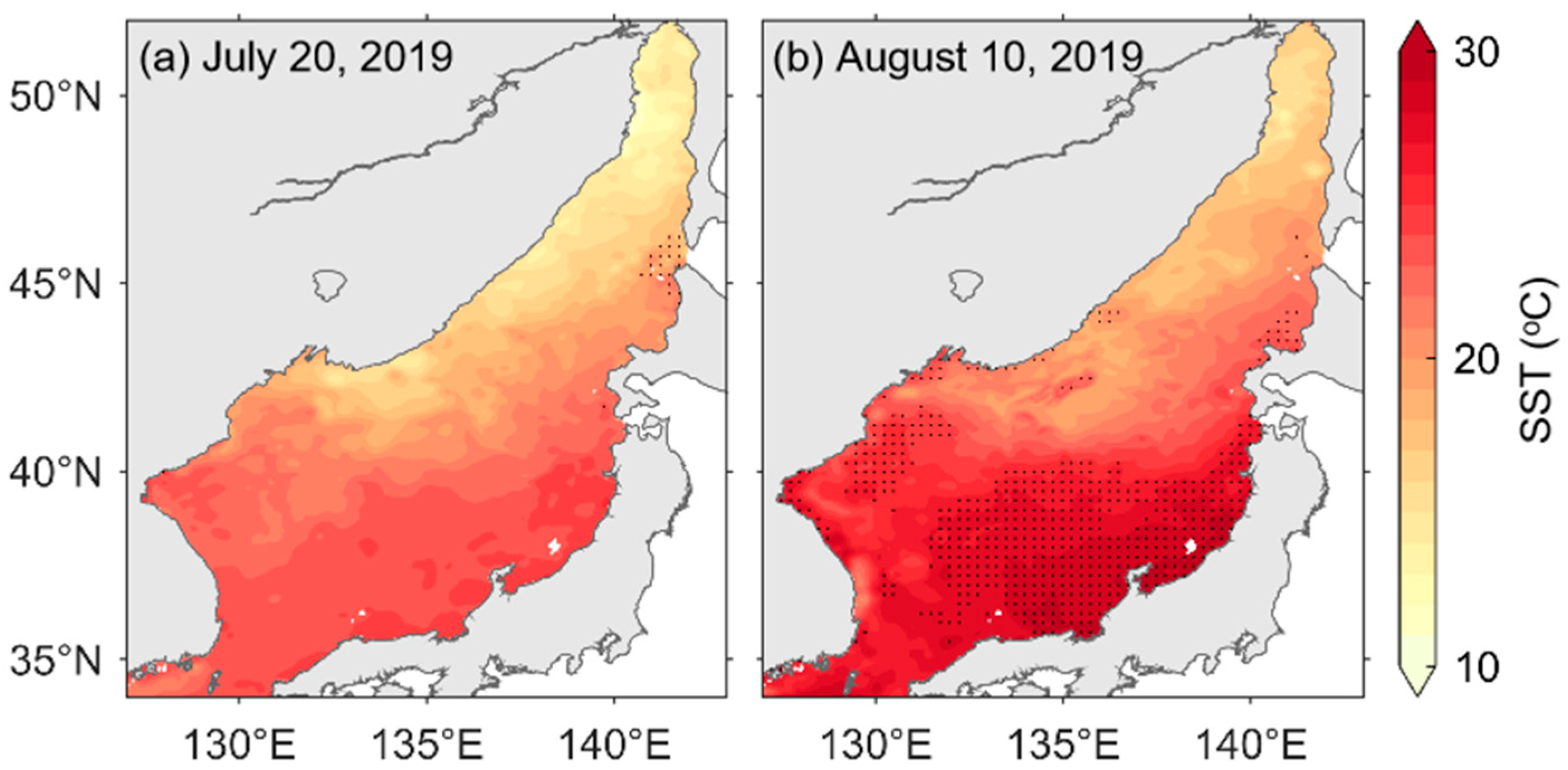
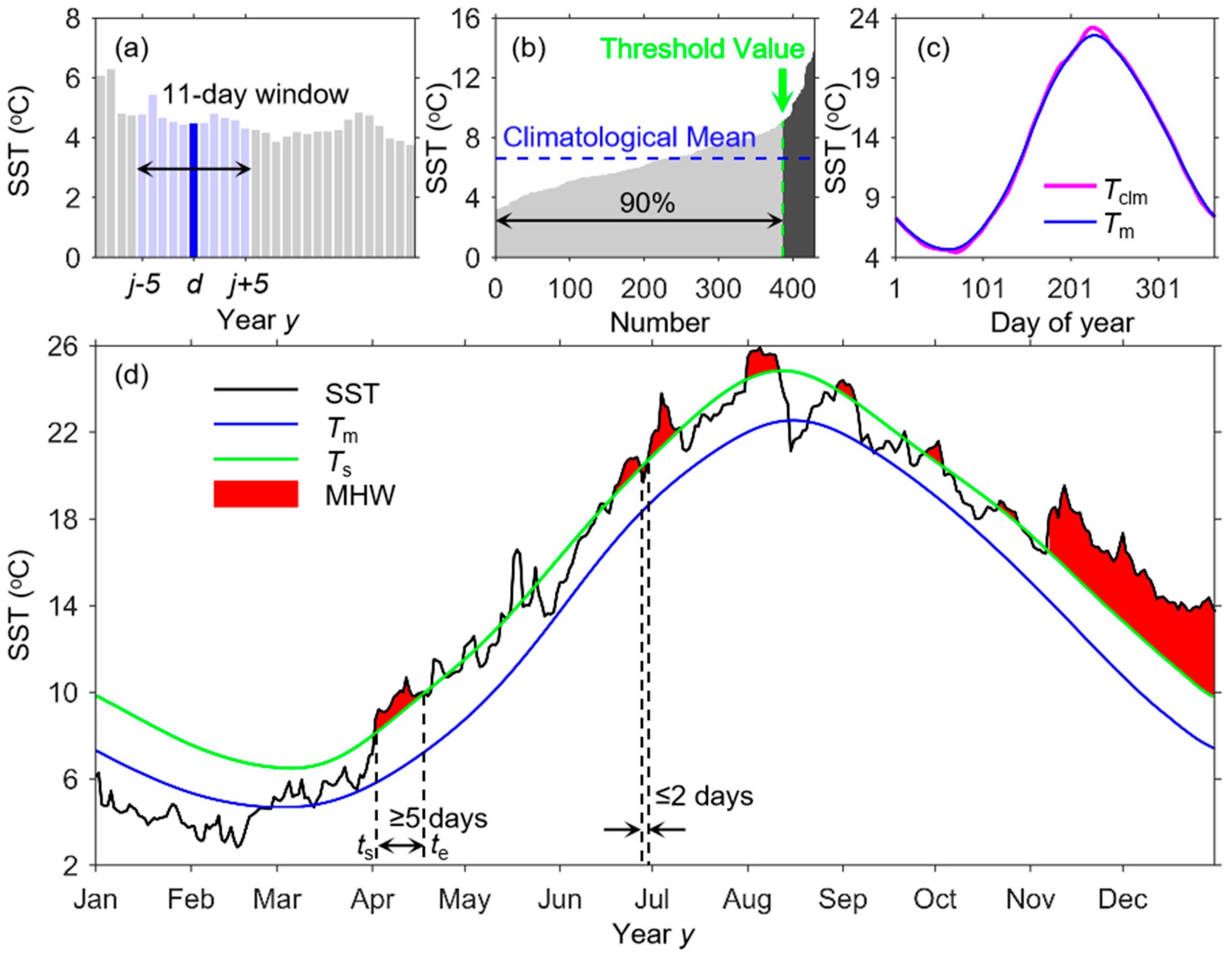


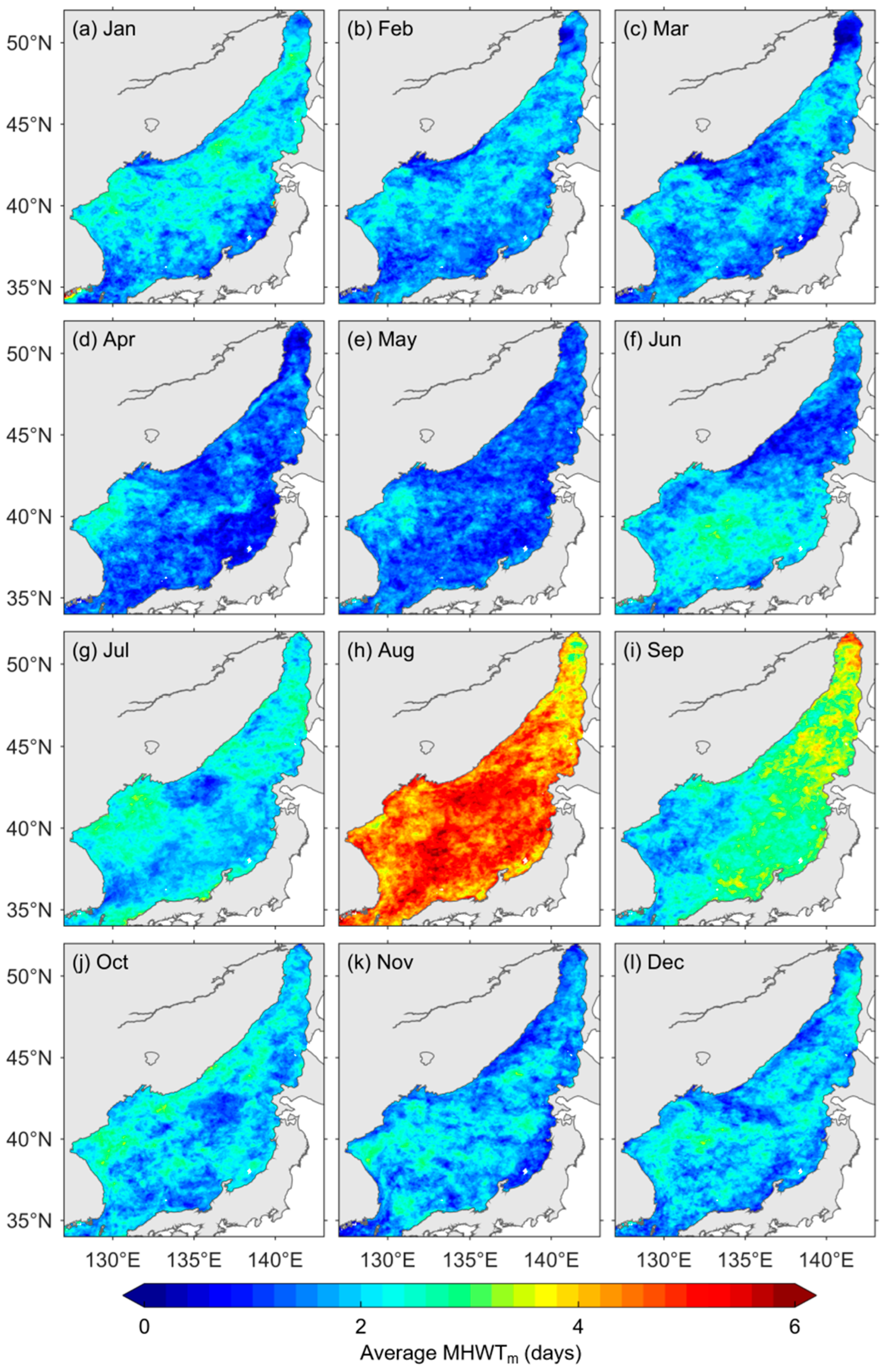
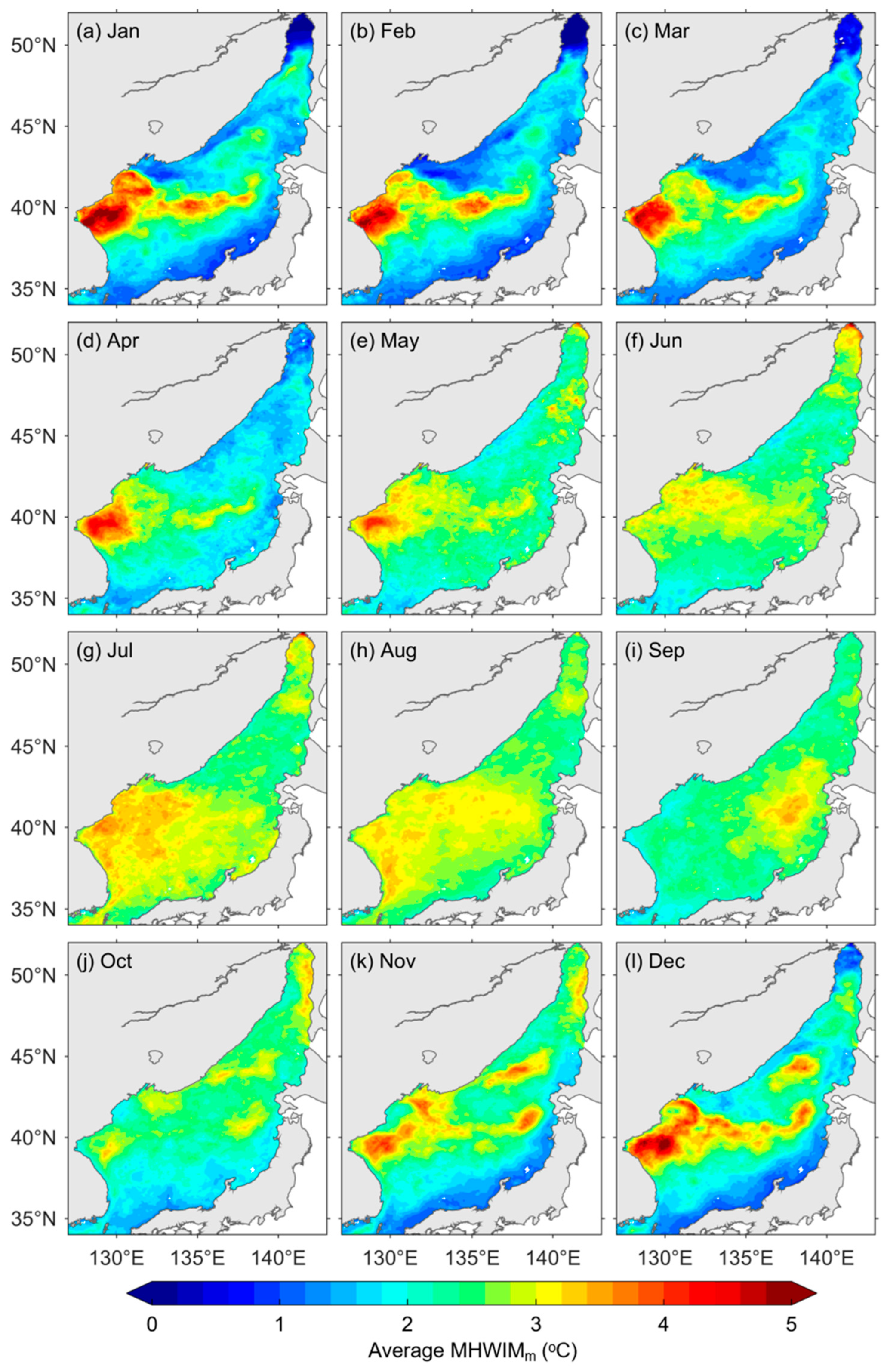
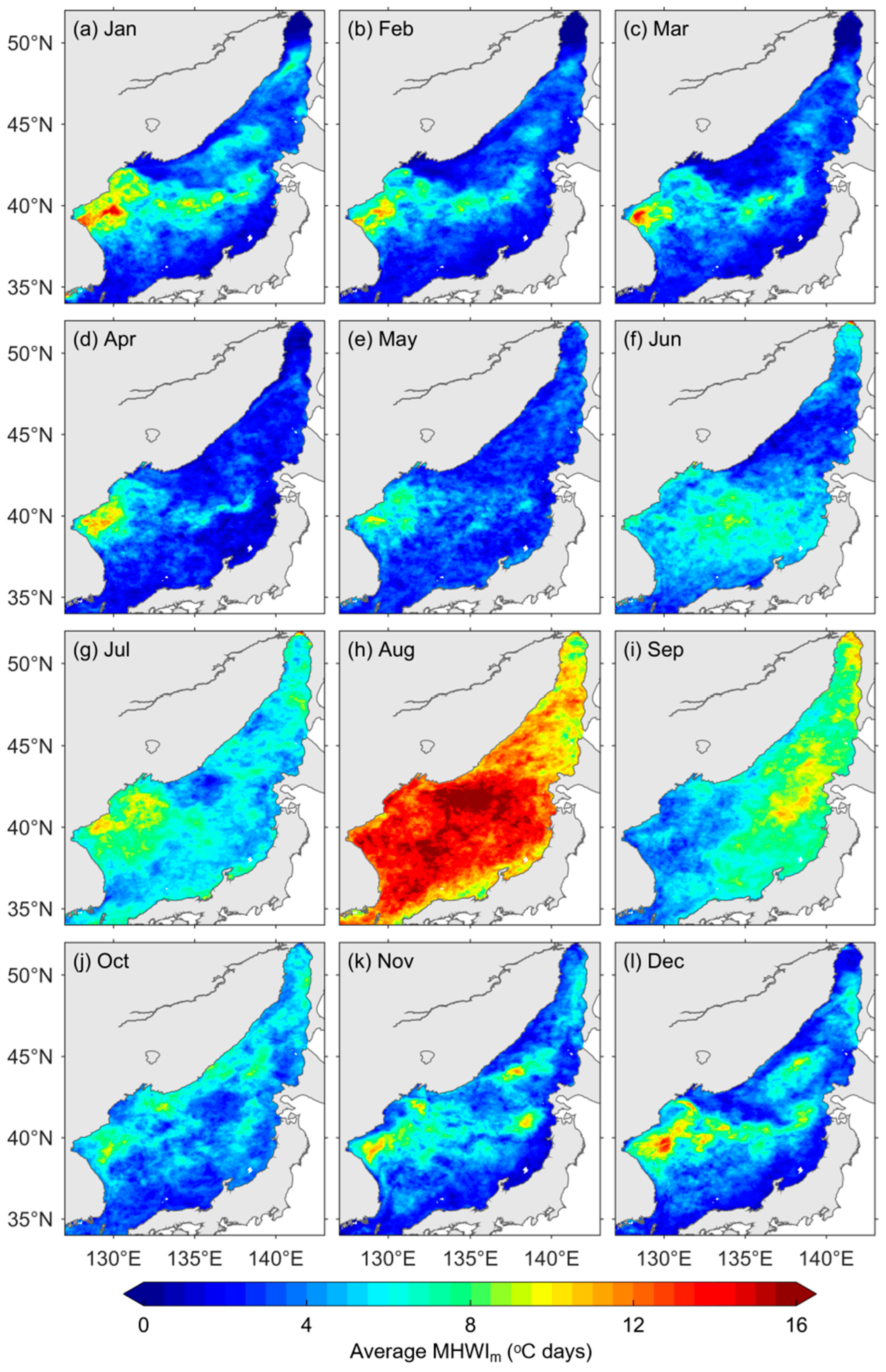

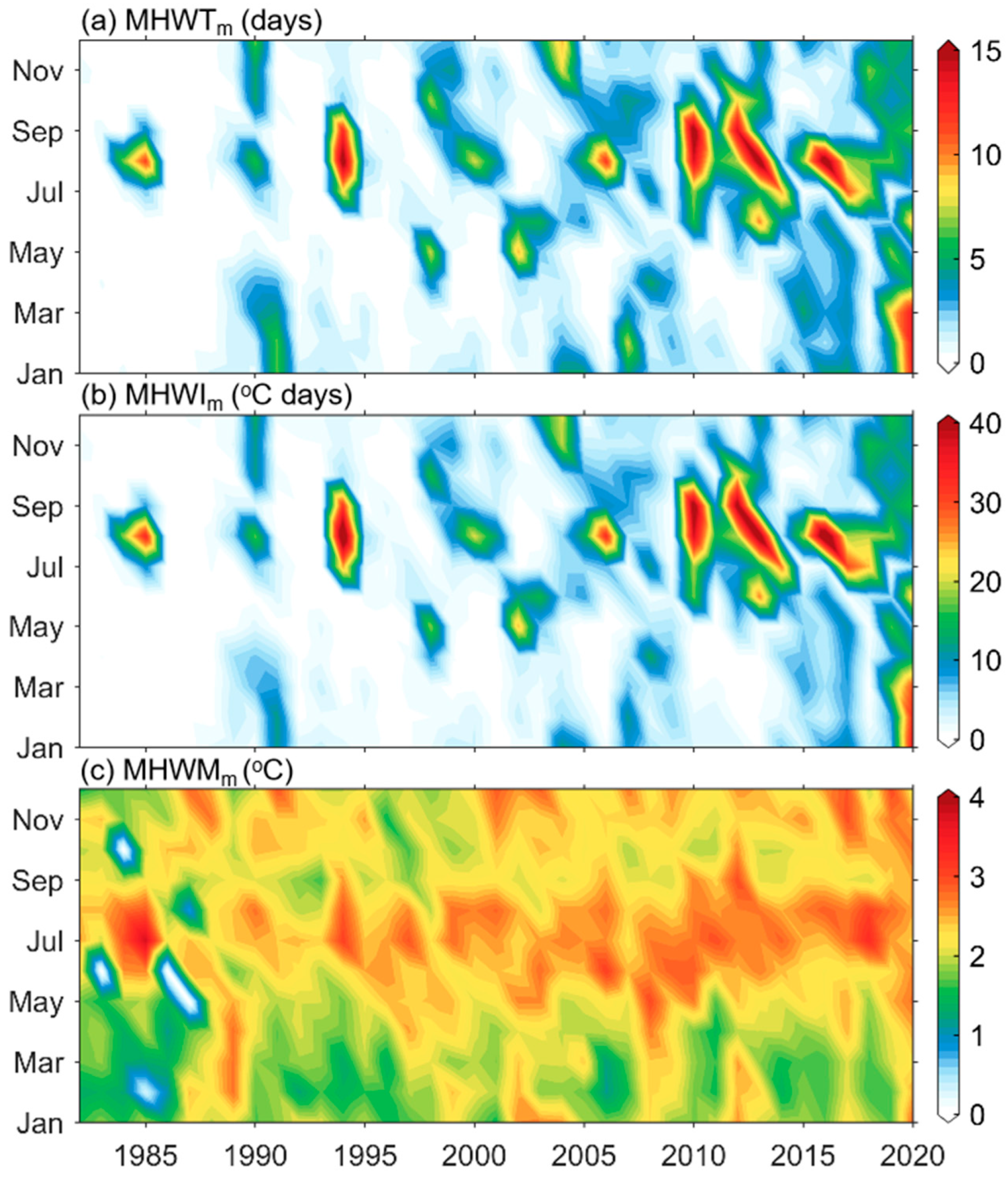
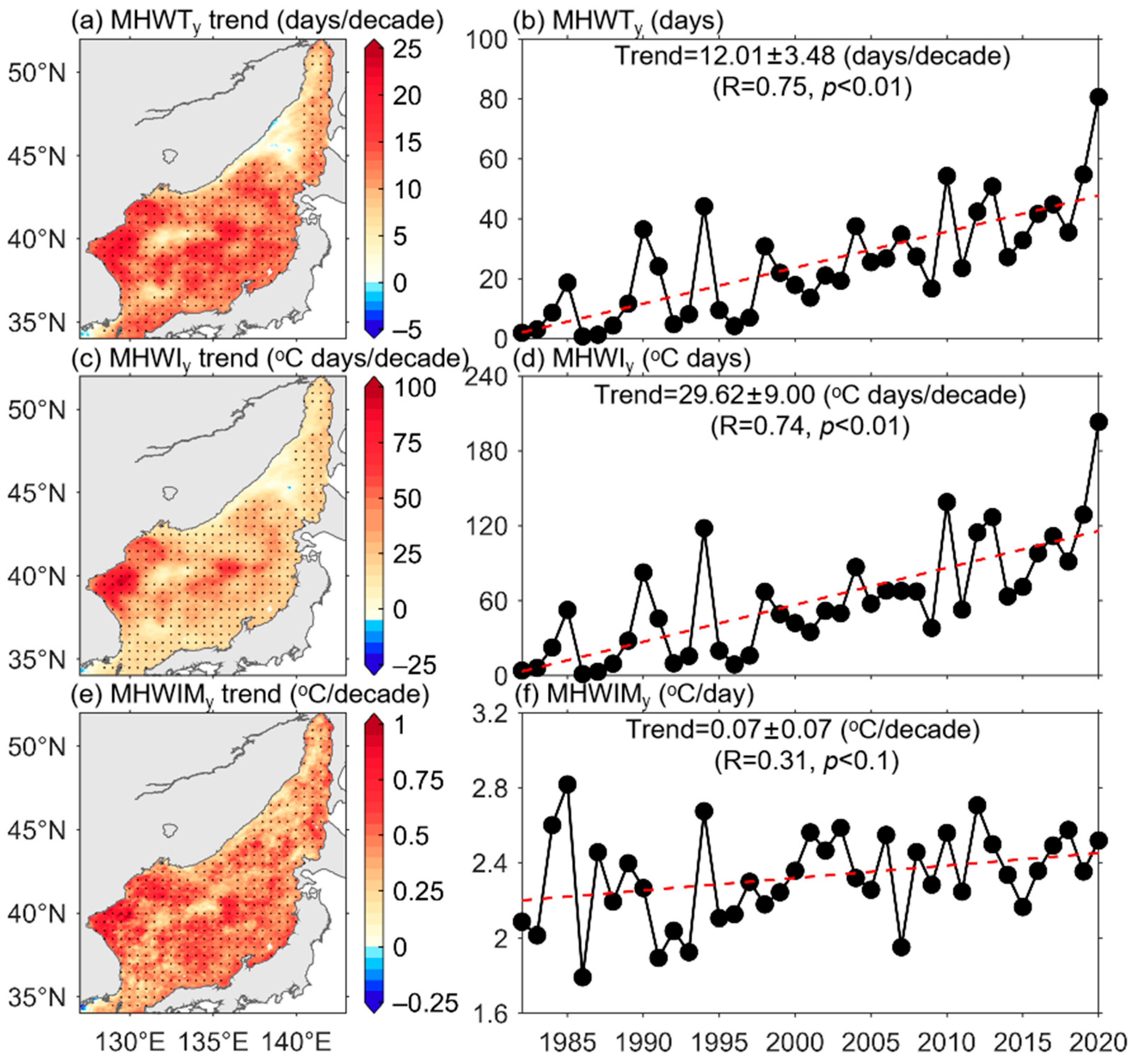
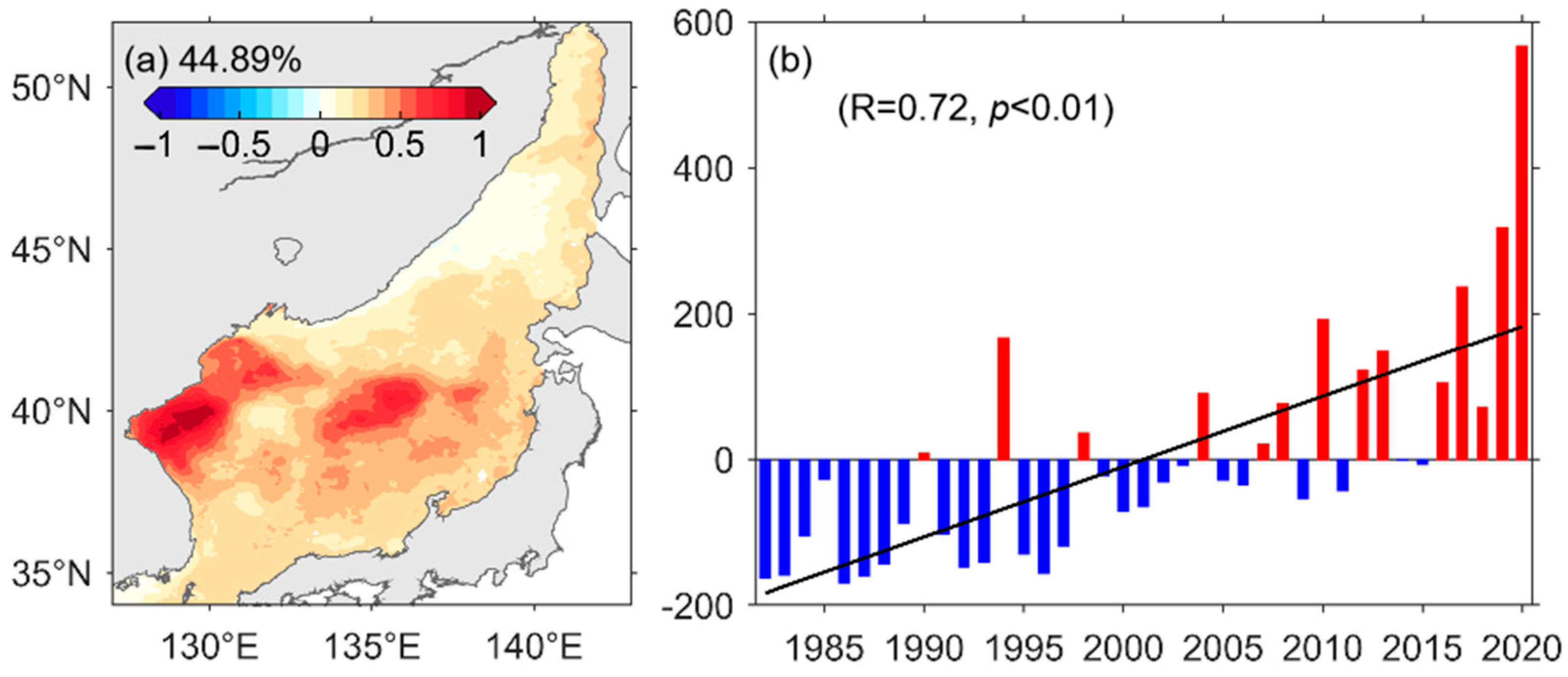
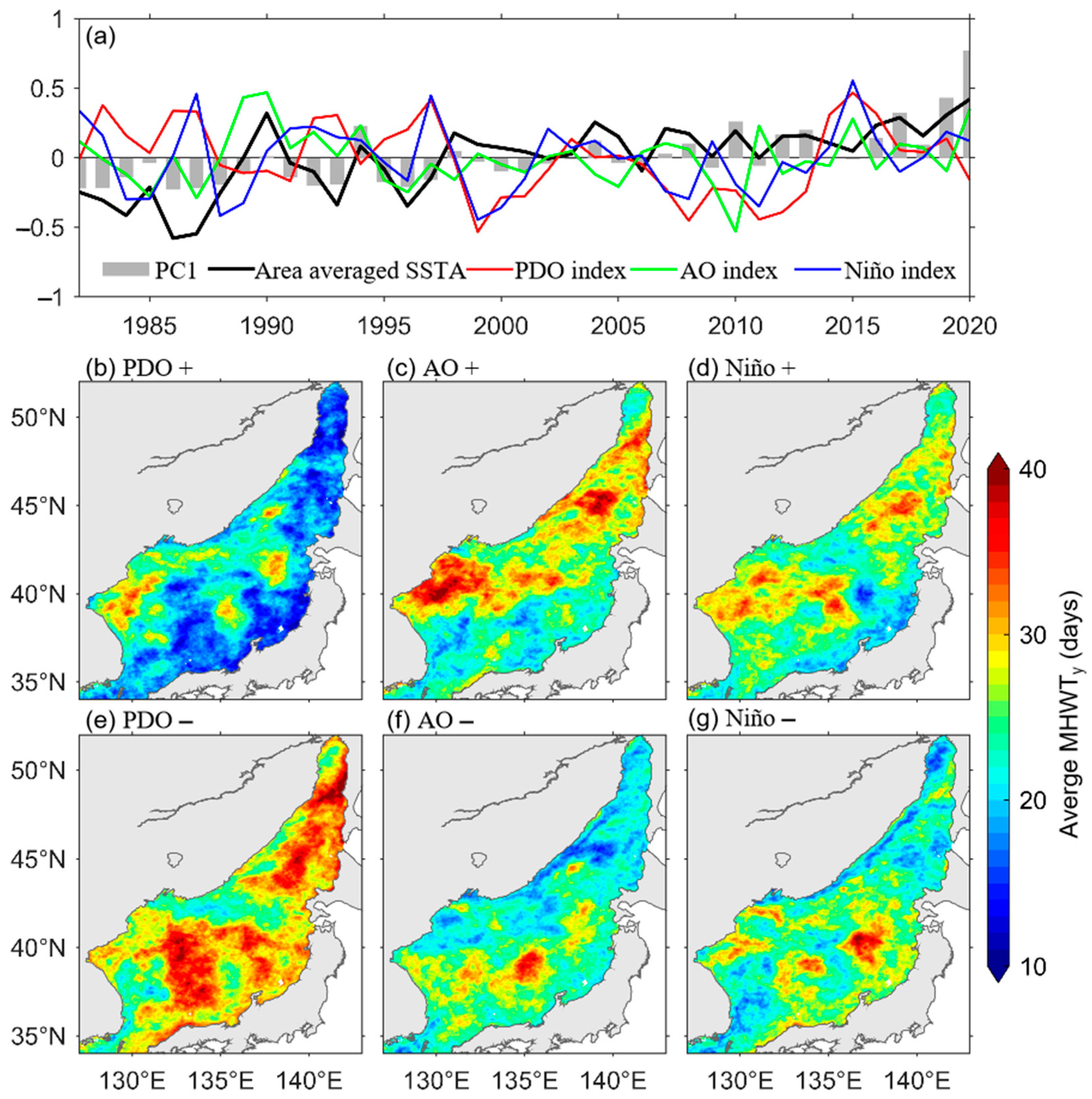
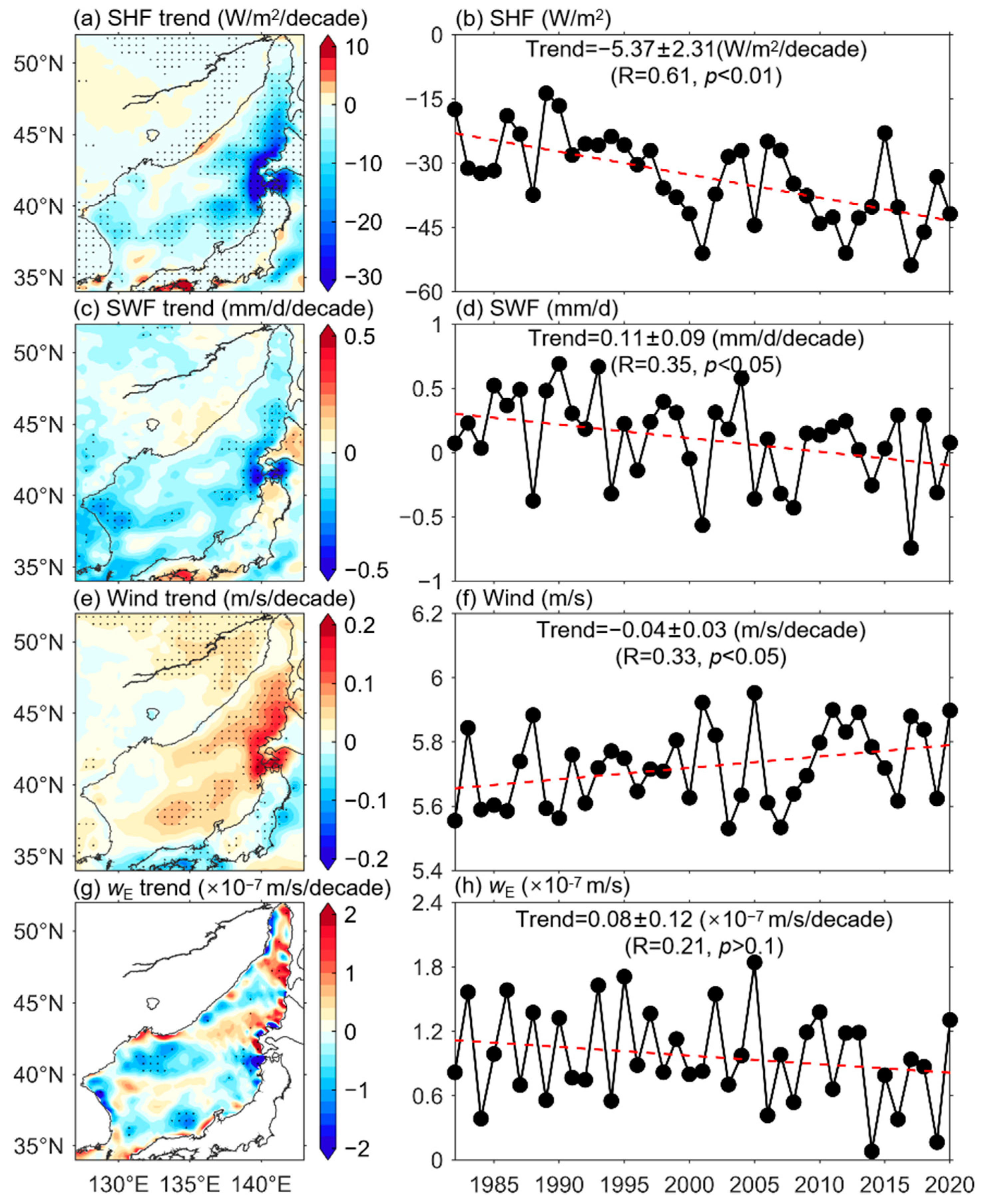
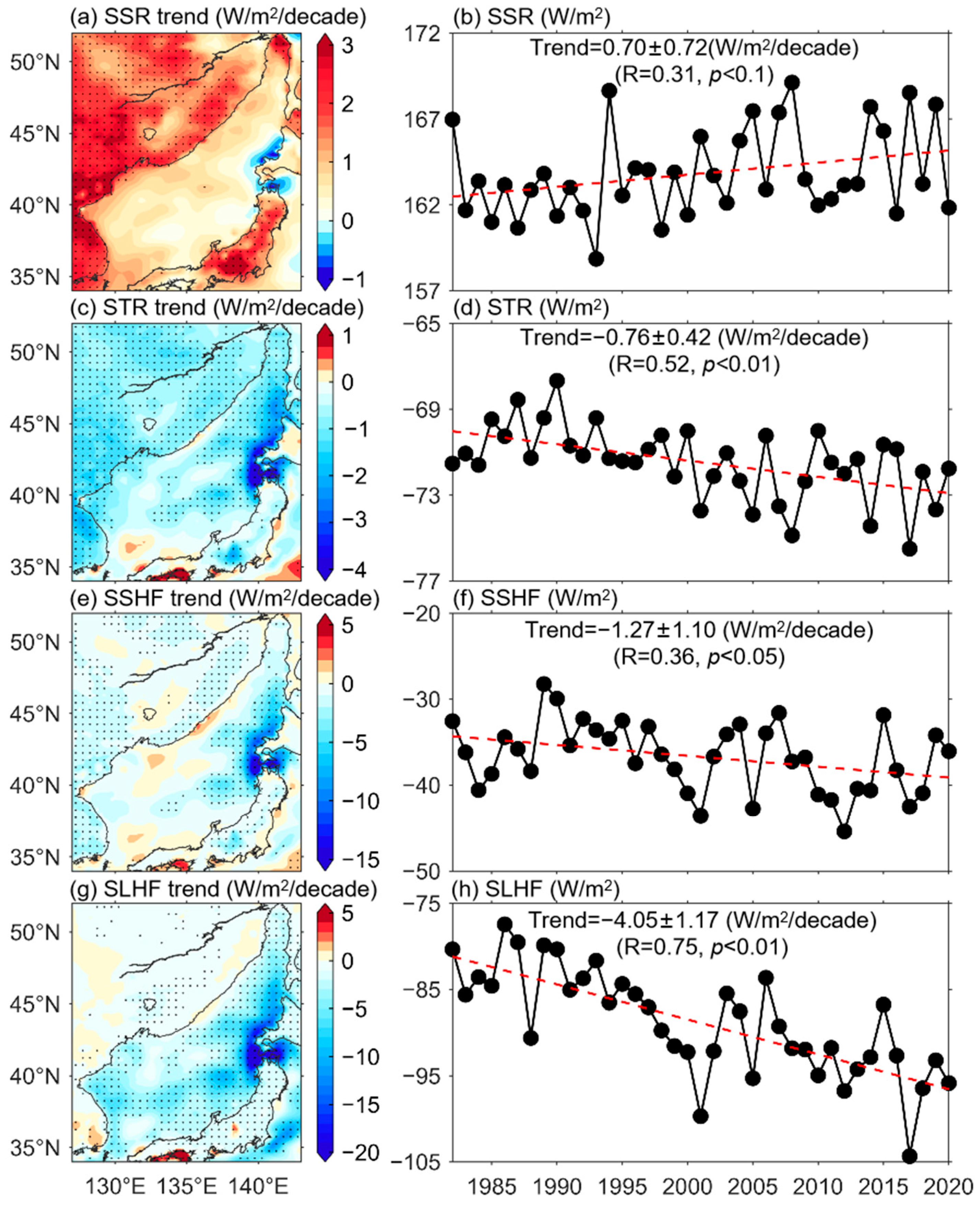

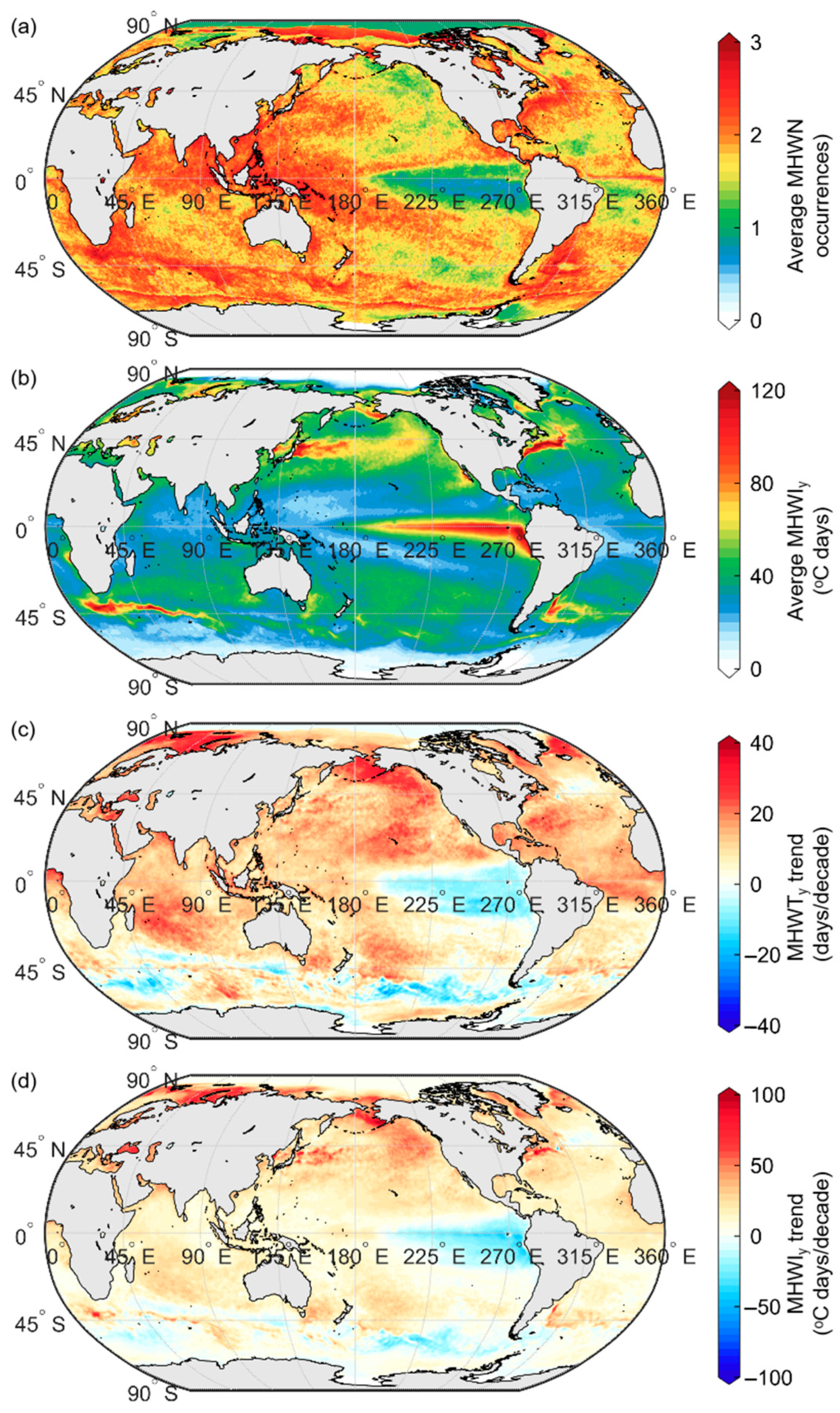
| Index | Definition | Formulas | Unit |
|---|---|---|---|
| MHWD | Duration of the MHW | + 1 | Days |
| Imax | Maximum intensity during the MHW | °C | |
| Imean | Mean intensity during the MHW | °C | |
| MHWN | Number of MHWs from ys to ye | MHWN | Occurrences |
| MHWT | Sum of MHW-day from Ds to De | Days | |
| MHWI | Sum of MHW-intensity from Ds to De | °C Days | |
| MHWIM | Mean MHW-intensity from Ds to De | °C |
| Area (Longitude and Latitude Range) | Average MHWN (Occurrences) | Average MHWTy (Days) | MHWIy (°C Days) | MHWTy Trend (Days/Decade) | MHWIy Trend (°C Days/Decade) |
|---|---|---|---|---|---|
| Global (0°–360° E, 90° S–90° N) | 1.82 | 63.12 | 32.69 | 8.54 | 12.37 |
| Japan/East Sea (127°–145° E, 32° N–52° N) | 1.97 (10) * | 24.86 (11) | 59.65 (3) | 12.01 (9) | 29.62 (3) |
| Equatorial Pacific cold tongue (180°–280° E, 5° S–5° N) | 1.17 | 30.77 | 67.13 | −3.36 | −11.95 |
| East China Seas (100°–127° E, 25° N–40° N) | 2.12 | 23.92 | 45.65 | 11.88 | 23.44 |
| South China Sea (100°–121° E, 0° N–13° N) | 2.33 | 26.18 | 32.19 | 12.05 | 14.41 |
| Bay of Bengal (80°–90° E, 5° N–22° N) | 2.27 | 23.94 | 25.14 | 10.08 | 10.21 |
| Arabian Sea (45°–79° E, 0° N–28° N) | 2.06 | 24.83 | 31.64 | 13.88 | 18.21 |
| Gulf Stream (280°–320° E, 32° N–50° N) | 2.12 | 26.04 | 58.05 | 13.54 | 27.95 |
| South coast of Africa (0°–80° E, 45° S–32° S) | 2.11 | 25.98 | 49.39 | 4.82 | 11.15 |
| East coast of South America (310°–335° E, 50° S–35° S) | 2.13 | 26.13 | 47.78 | 8.81 | 16.74 |
| Mediterranean Sea (0°–30° E, 30° N–45° N) | 1.92 | 24.86 | 45.32 | 16.31 | 29.90 |
| Gulf of Mexico and Caribbean (260°–290° E, 10° N–30° N) | 2.05 | 24.69 | 31.00 | 14.71 | 17.74 |
| East coast of Australia (140°–170° E, 45° S–30° S) | 1.94 | 26.70 | 42.30 | 12.41 | 21.96 |
| Indonesian sea (105–135° E, 10° S–0° S) | 2.27 | 27.97 | 31.65 | 13.36 | 14.68 |
| Western North Pacific Ocean (135°–225° E, 30° N–45° N) | 1.82 | 28.05 | 59.92 | 14.30 | 30.99 |
| Sea of Okhotsk (135°–165° E, 42° N–64° N) | 1.83 | 26.68 | 45.94 | 11.16 | 20.84 |
Publisher’s Note: MDPI stays neutral with regard to jurisdictional claims in published maps and institutional affiliations. |
© 2022 by the authors. Licensee MDPI, Basel, Switzerland. This article is an open access article distributed under the terms and conditions of the Creative Commons Attribution (CC BY) license (https://creativecommons.org/licenses/by/4.0/).
Share and Cite
Wang, D.; Xu, T.; Fang, G.; Jiang, S.; Wang, G.; Wei, Z.; Wang, Y. Characteristics of Marine Heatwaves in the Japan/East Sea. Remote Sens. 2022, 14, 936. https://doi.org/10.3390/rs14040936
Wang D, Xu T, Fang G, Jiang S, Wang G, Wei Z, Wang Y. Characteristics of Marine Heatwaves in the Japan/East Sea. Remote Sensing. 2022; 14(4):936. https://doi.org/10.3390/rs14040936
Chicago/Turabian StyleWang, Dingqi, Tengfei Xu, Guohong Fang, Shumin Jiang, Guanlin Wang, Zexun Wei, and Yonggang Wang. 2022. "Characteristics of Marine Heatwaves in the Japan/East Sea" Remote Sensing 14, no. 4: 936. https://doi.org/10.3390/rs14040936
APA StyleWang, D., Xu, T., Fang, G., Jiang, S., Wang, G., Wei, Z., & Wang, Y. (2022). Characteristics of Marine Heatwaves in the Japan/East Sea. Remote Sensing, 14(4), 936. https://doi.org/10.3390/rs14040936






